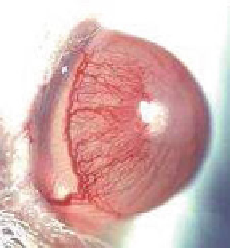Biomedical Engineering Reference
In-Depth Information
Fig. 1
Angiogenesis on a rat
cornea: experiment
performed at IFOM, FIRC
research centre [
14
]
In this way formation of aggregating networks (vessels) is shown as a consequence
of collective behavior. Figure
1
shows an example of real angiogenesis induced by a
biochemical substance playing the role of an angiogenic tumor on a rat cornea [
14
].
Based on the above discussion, the main features of the process of formation of
a tumour-driven vessel network are
1. Vessel branching
2. Vessel extension
- Chemotaxis, in response to a generic TAF, released by tumour cells
- Haptotatic migration, in response to fibronectin gradients, emerging from the
extracellular matrix, and through degradation and production by endothelial
cells themselves
3. Anastomosis, when a capillary tip meets an existing vessel
The initiation of sprouting from preexisting parental vessels is not considered
here; in order to avoid further mathematical technicalities, we assume a given
number
N
0
of initial capillary sprouts; we refer to literature [
23
] for details on this
topic.
2.1.1
Modelling the Evolution of the Capillary Network and the Coupling
with the Underlying Fields
We again denote by
N
a parameter of scale of the process. We model the network
by tracking the tip of vessels. Thus, the considered individual stochastic processes
are
Z
i
X
i
v
i
d
d
(
t
)=(
(
t
)
,
(
t
))
∈
R
×
R
,
which denote the location and the velocity of the tip of the
i
-th vessel at time
t
,
for
i
represents the number of tips at time
t
.The
network of endothelial cells is described by the union of the trajectories of the tips
as in Eq. (
1
).
=
1
,...,
N
(
t
)
,
respectively.
N
(
t
)

Search WWH ::

Custom Search